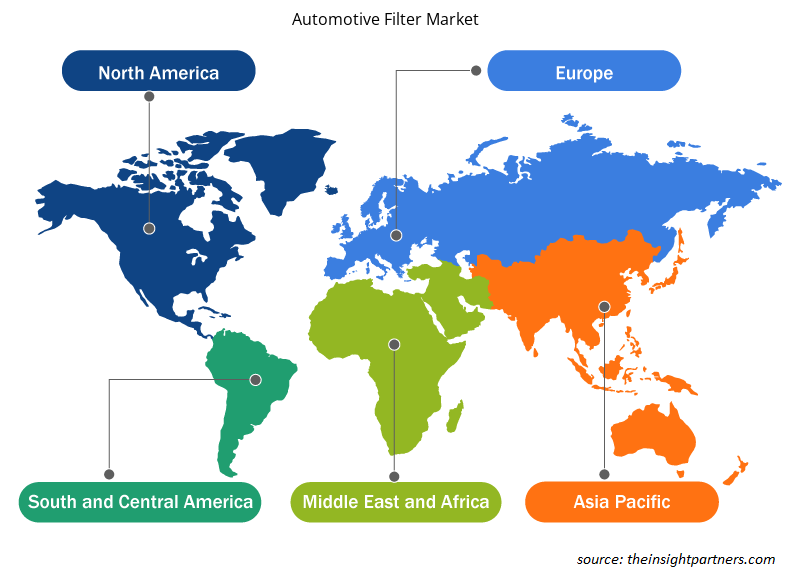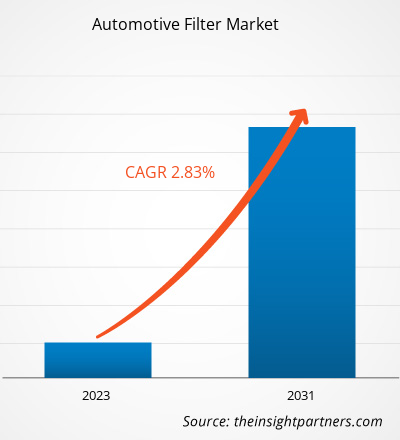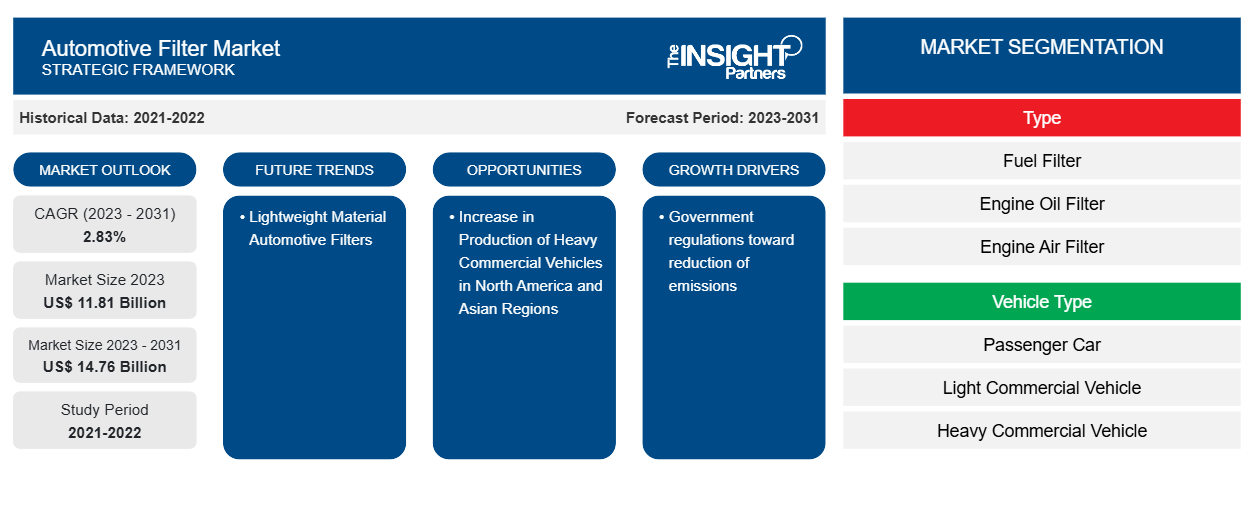Si prevede che il mercato dei filtri per autoveicoli raggiungerà i 14,76 miliardi di dollari entro il 2031, rispetto agli 11,81 miliardi di dollari del 2023. Si prevede che il mercato registrerà un CAGR del 2,83% nel 2023-2031.CAGR of 2.83% in 2023–2031. L'aumento delle normative governative e gli ingenti investimenti dei principali produttori di filtri nella riduzione delle emissioni stanno favorendo la crescita del mercato dei filtri per autoveicoli nello scenario attuale.
Analisi del mercato dei filtri per autoveicoli
Il North American Free Trade Agreement (NAFTA) ha firmato un accordo tra Stati Uniti, Canada e Messico. Questo accordo ha ridotto le barriere tariffarie e non tariffarie di maggioranza per il libero scambio e gli investimenti tra questi tre paesi. L'accordo ha inoltre contribuito ad aumentare il livello di commercio e investimenti nei paesi nordamericani. Il Nord America è un'economia ben sviluppata e gli individui hanno alti redditi disponibili a causa dell'elevato reddito pro capite del paese. Gli Stati Uniti e il Canada hanno un'alta densità di veicoli commerciali. Per quanto riguarda l'elevato reddito disponibile tra gli utenti finali, il North American Free Trade Agreement tra Stati Uniti, Canada e Messico ha portato le regioni a sperimentare un aumento sostanziale dei veicoli commerciali. Si prevede che il costante aumento di camion, rimorchi, autobus e altri veicoli pesanti catalizzerà la domanda di filtri per autoveicoli nei paesi nordamericani.capita income of the country. The U.S. and Canada have a high density of commercial vehicles. Pertaining to the high disposable income among the end users, and North American Free Trade Agreement between the US, Canada, and Mexico has led the regions to experience a substantial rise in commercial vehicles. The constant rise in trucks, trailers, buses, and other heavy-duty vehicles is anticipated to catalyze the demand for automotive filters in North American countries.
Panoramica del mercato dei filtri per autoveicoli
Si prevede che il mercato globale dei filtri per autoveicoli assisterà a una crescita promettente durante il periodo di previsione dal 2023 al 2031. Con l'aumento del reddito disponibile, il segmento delle auto di lusso e premium sta assistendo a una crescita impressionante delle vendite, che è uno dei principali fattori che guidano la crescita del mercato. Oltre a questi fattori, si prevede che anche il crescente numero di normative rigorose e requisiti di conformità guideranno la domanda.
Personalizza questo report in base alle tue esigenze
Riceverai la personalizzazione gratuita di qualsiasi report, comprese parti di questo report, o analisi a livello nazionale, pacchetto dati Excel, oltre a usufruire di grandi offerte e sconti per start-up e università
-
Scopri le principali tendenze di mercato in questo rapporto.Questo campione GRATUITO includerà analisi di dati che spaziano dalle tendenze di mercato alle stime e alle previsioni.
Driver e opportunità del mercato dei filtri per autoveicoli
Regolamentazioni governative per la riduzione delle emissioni
I filtri per autoveicoli sono sviluppati e progettati per limitare l'ingresso di particelle di sporco fini come fumi di scarico, pollini, batteri e altri nel carburatore e nel motore dell'auto. L'applicazione di questi filtri riduce ulteriormente gli inquinanti atmosferici emessi dai motori delle auto, il che si traduce in un prolungamento della durata utile del veicolo e una riduzione dei costi di manutenzione. Gli enti per le emissioni e i governi di tutto il mondo stanno imponendo severe leggi sulle emissioni per i veicoli che rilasciano gas pericolosi come monossido di carbonio (CO), ossido di azoto (NOx), idrocarburi (HC) e altri. Ad esempio, l'Environmental Protection Agency (EPA) negli Stati Uniti ha modificato standard come gli standard di risparmio di carburante per i veicoli commerciali leggeri e il programma nazionale per le emissioni di gas serra (GHG).pollens, bacteria, and others into the automotive carburetor and engine. The application of these filters further reduces the air pollutants that are emitted by the automotove engines, which results in, extends the service life of the vehicle, and reduces the maintenance cost. The emission bodies and governments around the world are imposing stringent emission laws for the vehicles that releases hazardous gases such as carbon monoxide (CO), nitrogen oxide (NOx), hydrocarbons (HC), and others. For instance, the Environmental Protection Agency (EPA) in the U.S. has amended standards such as fuel economy standards for the LCVs and national program for greenhouse gas emissions (GHG).
Inoltre, i conducenti, oggigiorno, avvertono ogni giorno l'impatto dell'aumento dei prezzi del petrolio alla pompa, a causa del quale la benzina sta diventando notevolmente costosa e la richiesta di soluzioni efficaci per ridurre il consumo di carburante sta diventando sempre più forte. Alcuni dei principali produttori di filtri hanno sviluppato una soluzione unica e ad ampio raggio basata su guarnizioni per la riduzione delle emissioni nei veicoli utilitari e passeggeri. Ad esempio, Freudenberg Filtration Technologies SE & Co. KG ha sviluppato le tecnologie di filtrazione che contribuiscono all'effettiva riduzione delle emissioni di CO2 attraverso i suoi filtri dell'aria di aspirazione del motore micronAir completamente sintetici che aiutano a proteggere risorse preziose. Inoltre, le crescenti perdite di pressione dei filtri dell'aria di aspirazione del motore stanno portando a una maggiore richiesta di energia a parità di potenza e poiché la resistenza del filtro aumenta a causa dei depositi di polvere, anche il consumo di carburante e le emissioni di CO2 stanno aumentando. Pertanto, i media filtranti ad alte prestazioni, il filtro dell'aria del motore offrono eccezionali proprietà di filtrazione e valori di efficienza energetica che garantiscono ulteriormente la riduzione delle emissioni dai veicoli.Freudenberg Filtration Technologies SE & Co. KG has developed the Filtration Technologies that contribute to the effective reduction of CO2 emissions through its fully synthetic micronAir engine intake air filters that help in protecting valuable resources. Further, the increasing pressure losses of engine intake air filters are leading to increased energy demand at the same output and as filter resistance increases owing to dust deposits, the fuel consumption and
Analisi della segmentazione del rapporto sul mercato dei filtri per autoveicoli
I segmenti chiave che hanno contribuito alla derivazione dell'analisi di mercato dei filtri per autoveicoli sono la tipologia e il tipo di veicolo.
- In base al tipo, il mercato dei filtri per autoveicoli è suddiviso in filtro carburante, filtro olio motore, filtro aria motore, filtro aria abitacolo, filtro aria refrigerante, filtro olio sterzo. Il segmento dei filtri aria motore ha detenuto una quota di mercato maggiore nel 2023.subsegmented into fuel filter, engine oil filter, engine air filter, cabin air filter, coolant air filter, steering oil filter. The engine air filter segment held a larger market share in 2023.
- In base al tipo di veicolo, il mercato dei propulsori elettrici è suddiviso in autovetture, veicoli commerciali leggeri e veicoli commerciali pesanti. Il segmento delle autovetture ha detenuto la quota maggiore del mercato nel 2023.
Analisi del mercato dei filtri per autoveicoli per area geografica
L'ambito geografico del rapporto sul mercato dei filtri per autoveicoli è suddiviso principalmente in cinque regioni: Nord America, Europa, Asia Pacifico, Medio Oriente e Africa e Sud America.
Nella regione APAC, la Cina è il mercato più grande grazie al suo mercato automobilistico leader. Inoltre, le crescenti vendite di componenti automobilistici stimoleranno la domanda di filtri per autoveicoli. La crescente adozione tecnologica e la crescente domanda di utilizzo di rimorchi e roulotte non motorizzati accelereranno la crescita del mercato dei filtri per autoveicoli. Inoltre, la domanda di veicoli per autoveicoli nella regione APAC, insieme alla crescente produzione di autovetture e veicoli commerciali in Cina e in altri paesi, consentiranno ai produttori di filtri per autoveicoli di aumentare la loro presenza in questa regione.
Approfondimenti regionali sul mercato dei filtri per autoveicoli
Le tendenze regionali e i fattori che influenzano il mercato dei filtri per autoveicoli durante il periodo di previsione sono stati ampiamente spiegati dagli analisti di Insight Partners. Questa sezione discute anche i segmenti e la geografia del mercato dei filtri per autoveicoli in Nord America, Europa, Asia Pacifico, Medio Oriente e Africa e Sud e Centro America.

- Ottieni i dati specifici regionali per il mercato dei filtri per autoveicoli
Ambito del rapporto sul mercato dei filtri per autoveicoli
| Attributo del report | Dettagli |
|---|---|
| Dimensioni del mercato nel 2023 | 11,81 miliardi di dollari USA |
| Dimensioni del mercato entro il 2031 | 14,76 miliardi di dollari USA |
| CAGR globale (2023-2031) | 2,83% |
| Dati storici | 2021-2022 |
| Periodo di previsione | 2023-2031 |
| Segmenti coperti |
Per tipo
|
| Regioni e Paesi coperti |
America del Nord
|
| Leader di mercato e profili aziendali chiave |
|
Densità dei player del mercato dei filtri per autoveicoli: comprendere il suo impatto sulle dinamiche aziendali
Il mercato Automotive Filter Market sta crescendo rapidamente, spinto dalla crescente domanda degli utenti finali dovuta a fattori quali l'evoluzione delle preferenze dei consumatori, i progressi tecnologici e una maggiore consapevolezza dei vantaggi del prodotto. Con l'aumento della domanda, le aziende stanno ampliando le loro offerte, innovando per soddisfare le esigenze dei consumatori e capitalizzando sulle tendenze emergenti, il che alimenta ulteriormente la crescita del mercato.
La densità degli operatori di mercato si riferisce alla distribuzione di aziende o società che operano in un particolare mercato o settore. Indica quanti concorrenti (operatori di mercato) sono presenti in un dato spazio di mercato in relazione alle sue dimensioni o al valore di mercato totale.
Le principali aziende che operano nel mercato dei filtri per autoveicoli sono:
- Filtro AL
- Società a responsabilità limitata ACDelco Inc.
- Società Denso
- Società per azioni Donaldson Inc.
- Freudenberg Filtration Technologies SE & Co. KG, K&N Engineering, Inc.
- MANN+HUMMEL GMBH
Disclaimer : le aziende elencate sopra non sono classificate secondo un ordine particolare.

- Ottieni una panoramica dei principali attori del mercato dei filtri per autoveicoli
Notizie e sviluppi recenti sul mercato dei filtri per autoveicoli
Il mercato dei filtri per autoveicoli viene valutato raccogliendo dati qualitativi e quantitativi dopo la ricerca primaria e secondaria, che include importanti pubblicazioni aziendali, dati associativi e database. Di seguito è riportato un elenco degli sviluppi nel mercato dei filtri per autoveicoli e delle strategie:
- Ad aprile 2024, Ahlstrom ha introdotto una nuova tecnologia di media filtranti a doppio strato, disponibile a livello globale, che rappresenta un balzo in avanti nella filtrazione ed è una soluzione perfetta per soddisfare le future esigenze del mercato. Il design a doppio strato offre fino al doppio della capacità di ritenzione della polvere rispetto al design a strato singolo, poiché ogni strato ha uno scopo distinto per ottimizzare la ritenzione complessiva delle particelle nella profondità del materiale. (Fonte: DJI, comunicato stampa/sito Web aziendale/newsletter)
- Ad aprile 2023, Ahlstrom introduce una nuova gamma di soluzioni di filtrazione rinnovabili e sostenibili per applicazioni automobilistiche. Ahlstrom ECO™ è una tecnologia che supporta le crescenti richieste di sostenibilità del mercato globale dei trasporti e offre una nuova scelta per i produttori di filtri. (Fonte: Flyability, comunicato stampa/sito Web aziendale/newsletter)
Copertura e risultati del rapporto sul mercato dei filtri per autoveicoli
Il rapporto “Dimensioni e previsioni del mercato dei filtri per autoveicoli (2021-2031)” fornisce un’analisi dettagliata del mercato che copre le seguenti aree:
- Dimensioni e previsioni del mercato a livello globale, regionale e nazionale per tutti i segmenti di mercato chiave coperti dall'ambito
- Dinamiche di mercato come fattori trainanti, vincoli e opportunità chiave
- Principali tendenze future
- Analisi dettagliata delle cinque forze di Porter
- Analisi di mercato globale e regionale che copre le principali tendenze di mercato, i principali attori, le normative e gli sviluppi recenti del mercato
- Analisi del panorama industriale e della concorrenza che copre la concentrazione del mercato, l'analisi della mappa di calore, i principali attori e gli sviluppi recenti
- Profili aziendali dettagliati con analisi SWOT
- Analisi storica (2 anni), anno base, previsione (7 anni) con CAGR
- Analisi PEST e SWOT
- Valore/volume delle dimensioni del mercato - Globale, Regionale, Nazionale
- Industria e panorama competitivo
- Set di dati Excel
Report recenti
Testimonianze
Motivo dell'acquisto
- Processo decisionale informato
- Comprensione delle dinamiche di mercato
- Analisi competitiva
- Analisi dei clienti
- Previsioni di mercato
- Mitigazione del rischio
- Pianificazione strategica
- Giustificazione degli investimenti
- Identificazione dei mercati emergenti
- Miglioramento delle strategie di marketing
- Aumento dell'efficienza operativa
- Allineamento alle tendenze normative























 Ottieni un campione gratuito per - Mercato dei filtri per autoveicoli
Ottieni un campione gratuito per - Mercato dei filtri per autoveicoli